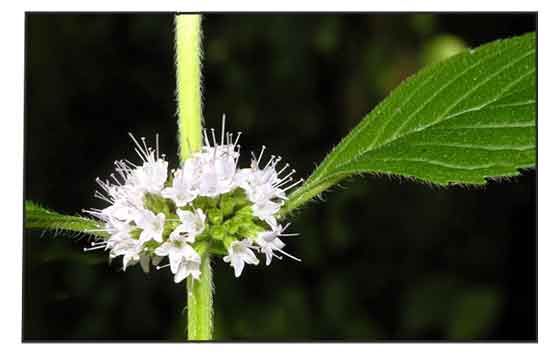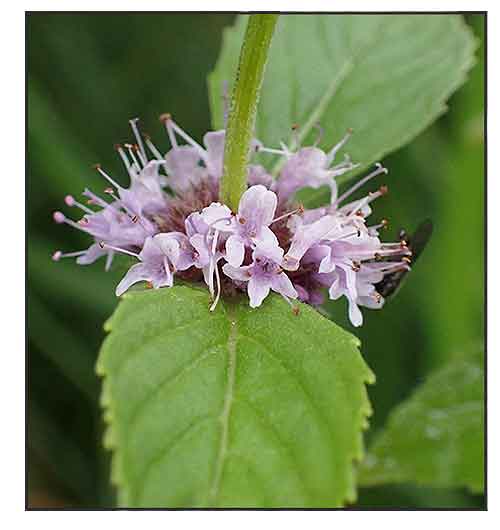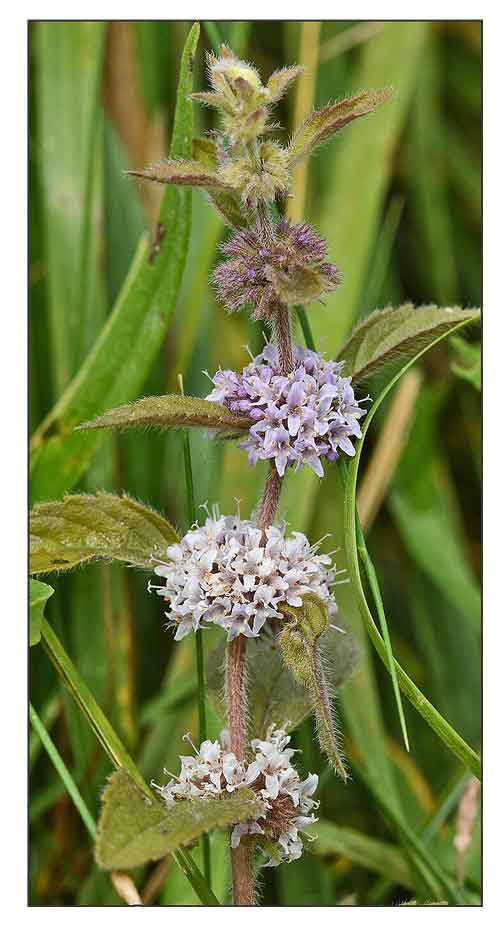 Gen info Gen info
- Mentha, also known as mint, is a genus of flowering plants in the mint family, Lamiaceae.
It is estimated 13 to 14 species exist, but the exact distinction between species is unclear.
- More than 3,000 names have been published with the genus Mentha, at ranks from species to forms, the majority of which are regarded as synonyms or illegitimate names. Variability of hybrids has led to "paroxysms of species and subspecific taxa". For example, one taxonomist published 434 new mind taxa for central Europe alone between 1922 and 116. Recent sources recognize between 18 and 24 species. As of December 2020, Plants of the World Online recognized 24 species. (15)
-
Mentha canadensis was first described by Carl Linnaeus in 1753. It has been described under a large number of synonyms, before being raised to a status of full species.
- Etymology: The genus name Mentha derives from Greek mintha, referring to Minthe or Menthe, in Greek mythology, the nymph transformed into a mint plant by Persephone. The specific epithet canadensis refers to Canada, were the plant was first described.
- Production of cornmint oil from M. canadensis is >15,000 tons/year, the most important source of menthol.
- Worldwide cultivation for its
essential oil and menthol production.
Botany
• Plants rhizomatous, perennial. Stems erect, 30-60 cm, puberulent, much branched. Petiole 2-10 mm; leaf blade ovate-lanceolate to oblong, 3-5(-7) × 0.8-3 cm, puberulent, base cuneate to rounded, margin remotely coarse dentate-serrate above base, apex acute. Verticillasters axillary, globose, ca. 1.8 cm in diam.; peduncle 0-3 mm. Pedicel slender, 2.5 mm. Calyx tubular-campanulate, ca. 2.5 mm, puberulent, glandular, obscurely 10-veined; teeth narrowly triangular-subulate, apex acuminate, ca. 1 mm. Corolla purplish or white, ca. 4 mm, puberulent; upper lobe largest, 2-lobulate; other lobes subequal, oblong, obtuse. Stamens ca. 5 mm. Nutlets yellow-brown, small pitted. (Flora of China)
• Mentha canadensis is a perennial plant with an underground creeping rhizome and upright shoots. It can grow to a height of about 18 inches (460 mm). It has hairy stems bearing opposite pairs of leaves. Each leaf is borne on a short stalk and has a wedge-shaped base and is lanceolate or ovate, with a toothed margin and a hairy surface. The flowers are borne in spikes at the tips of the shoots. The flowers may be bluish, pink or white. They are arranged in a spiral around the inflorescence. Each flower has five sepals, four petals, four stamens and a superior ovary. The fruits are dry and split open when ripe releasing the two seeds. (11)
 Distribution Distribution
- Native to the Philippines. (1) (2)
- In Luzon, Mindoro, and Samar; 150-1200 m. (1)
- Also native to Alaska, Alberta, Amur, Arizona, Arkansas, British Columbia, Buryatiya, California, Cambodia, China North-Central, China South-Central, China Southeast, Chita, Colorado, Connecticut, Delaware, Florida, Georgia, Idaho, Illinois, Indiana, Inner Mongolia, Iowa, Irkutsk, Japan, Jawa, Kansas, Kentucky, Khabarovsk, Korea, Krasnoyarsk, Kuril Is., Labrador, Laos, Lesser Sunda Is., Maine, Malaya, Maluku, Manchuria, Manitoba, Maryland, Massachusetts, Mexico Central, Mexico Northeast, Mexico Northwest, Michigan, Minnesota, Missouri, Mongolia, Montana, Myanmar, Nebraska, Nevada, New Brunswick, New Hampshire, New Jersey, New Mexico, New York, Newfoundland, North Carolina, North Dakota, Northwest Territories, Nova Scotia, Ohio, Oklahoma, Ontario, Oregon, Pennsylvania, Primorye, Qinghai, Québec, Rhode I., Sakhalin, Saskatchewan, South Dakota, Sri Lanka, Sulawesi, Sumatera, Tennessee, Texas, Thailand, Tibet, Tuva, Utah, Vermont, Vietnam, Virginia, Washington, West Virginia, Wisconsin, Wyoming, Xinjiang, Yakutiya, Yukon. (2)
- Cuultivated throughout the world.
Constituents
- Study of Mentha canadensis isolated two new
compounds, 3,4-dihydro-3,6,7-trihydroxy-2(1H)-quinolinone (1), (E)-2-methoxy-2- oxethyl-3-(4-hydroxyphenyl) acrylate (2), along with nine known phenolic compounds, syringic acid (3), p-coumaric acid (4), esculetin (5), methyl rosmarinate (6), nepetoidin B (7), syringaresinol (8), methyl ester of caffeoyl glycollc acid (9), 2″,3″-diacetylmartynoside (10) and bracteanolide A (12). Additionally, cis-3-[2-[1-(3,4-dihydroxyphenyl)-1-hydroxymethyl]-1,3-benzodioxol-5-yl]-(E)-2-propenoic acid (11),
which was isolated as a natural product for the first time. (6)
Properties
- Studies have suggested anti-inflammatory, antioxidant, α-glucosidase inhibitory, anti-obesity, anti-hepatic steatosis properties.
Parts used
Leaves, aerial parts, essential oil.
 Uses Uses
Edibility
- Leaves are edible, raw or cooked. Used as flavoring for salads and cooked foods. Flavor varies from mild to strong akin to peppermint. (4)
- Herbal tea made from fresh or dried leaves.
- Essential oil from plant used as flavoring in sweets and beverages.
(4)
- Used for making mint jelly, mint tea, and mint leaf candy.
Folkloric
- The Manobo in Agusan del Sur, Philippines, use decoction or infusion of leaves drunk for sinusitis, cough, stomach aches, vomiting, delayed menstruation, back aches, body aches, headaches, fever, gas pains, and flatulence. Decoction of leaves also used as wash for skin rashes, itching, rheumatism, cuts and wounds, animal and insect bites. Leaf sap is applied to ringworm, ear infection and congestion, and toothache. Poultice of leaves applied to muscle pain, abdominal pains, cuts and wounds, dislocation, and snake bites. (3)
- Essential oil is antiseptic, but toxic in large doses can cause abortion. (4)
Others
- Repellent: Plant used as insect repellent. Rats and mice intensely dislike the smell of mint. Plant is strewn in granaries to keep rodents off the grain. (4)
- Essential oil: Oil contains 60-85% menthol and is used medicinally as flavoring for pharmaceutical products and as flavoring for toothpastes, foods, cigarettes, and alcoholic beverages. Also used as perfume ingredient in soaps, lotions, and colognes. Also used as substitute or adulterant of peppermint oil. (4) M. canadensis produces corn mint oil, which represents the most important source of (-) menthol. (7)
- Agroforestry: Mint species are good bee and butterfly attractant plants, supplying them with good quality pollen and nectar. As aromatic plants, they make good companions for cabbages and tomatoes, the aromatic nature helping repel insect pests. (4)
Studies
• Anti-Inflammatory / Non-Essential Oils: Study evaluated non-essential oils of Mentha canadensis and its anti-inflammatory potential. Cinnamic acid derivatives were identified as potent anti-inflammatory agents. Analysis of Molecular Networking (MN) database analysis identified 14 metabolites. Compounds within the bioactive MN clusters demonstrated significant inhibition of reactive oxygen species, playing a crucial role in the management of oxidative stress. The compounds also suppressed the formation of neutrophil extracellular traps. Salvianolic acid B demonstrated dose-dependent anti-inflammatory effects (IC50 0.08 µM) and was promoted as the chemical marker of M. canadensis for its potential anti-inflammatory effect. (5)
• Antioxidant / Essential Oil: GC/FID and GC-MS study of cornmint essential oil yielded main constituents of menthol (41.2%) and menthone (20.4%). The cornmint oil showed antiradical activity with IC50 of 365.0 µg/mL for DPPH and 0.3 µg/mL for OH, indicating antioxidant activity of OH was higher than quercetin. The oil demonstrated antioxidant activity in a linoleic acid emulsion model system, with 0.1% concentration inhibiting the formation of conjugated dienes by 57.1% and generation of secondary oxidized products of linoleic acid by 76.1%. (8)
• α-Gluucosidase Inhibitory Activity / Aerial Parts: Mentha haplocalyx is widely used in traditional Chinese medicine, and the aerial parts are found to significantly inhibit activity of α-glucosidase with IC50 of 21.0 µg/mL. Bioactivity-guided isolation yielded two new compounds (1,2), together with 23 known compounds (2-25). Compounds 1-17 and 21-25 were evaluated for α-glucosidase inhibitory activities. Compound 11 showed most activity with IC50 of 83.4 µM. (9)
• Anti-Viral / SARS-CoV-2 Mutation / Dried Aerial Parts: Study of dried aerial parts isolated seven constituents. Syringic acid and methyl rosmarinate (MR) were evaluated in drug combination treatment. Ten amide derivatives of MR were synthesized, and the dodecyl (13) and 3-ethylphenyl (19) derivatives demonstrated significant improvement in the anti-SARS-CoV-2 plaque reduction assay, achieving IC50 of 0.77 and 2.70 µM, respectively against Omicron BA.1 compared to MR's IC50 of 57.0 µM. Results showed natural products with anti-Omicron BA.1 activity were isolated from M. canadensis and derivatives of MR were synthesized, which showed 21- to 74-fold improvement in antiviral activity against Omicron BA.1. (10)
• Attenuation of Adiposity and Hepatic Steatosis: Obesity is a major risk factor for metabolic syndrome. Study evaluated the effects of M. canadensis (MA) on obesity in a mice fed a normal diet (ND) or a high-fat diet (HFD) for 4 weeks. After 4 wks, the HFD-group was divided into 2 groups, one continued feeding with HFD, the other HFD with 1.5% (w/w) MA extract. Results showed significantly decreased body and white adipose tissue weights in the MA-supplemented group, with enhanced energy expenditure, improved plasma lipids, cytokines, hepatic steatosis, and fecal lipids. Results showed MA has the potential to improve diet-induced obesity and its associated complications, including adiposity, dyslipidemia, hepatic steatosis, and inflammation. (12)
• Chemical Diversity of Essential Oil from Mint Species: Study evaluated the content and chemical diversity of EO from 37 genotypes of Mentha from Southern Brazil. Essential oil was obtained by hydrodistillation, and components were identified and quantified using GC-MS. Mentha canadensis L. 'Japanese Field Mint" had the highest EO yield. Main constituents in the genotypes in the study were linalool, menthone, pulgeone, carvone, piperitone oxide and menthol. (13)
Availability
- Wild-crafted.
- Seeds in the cybermarket.
|

![]()






